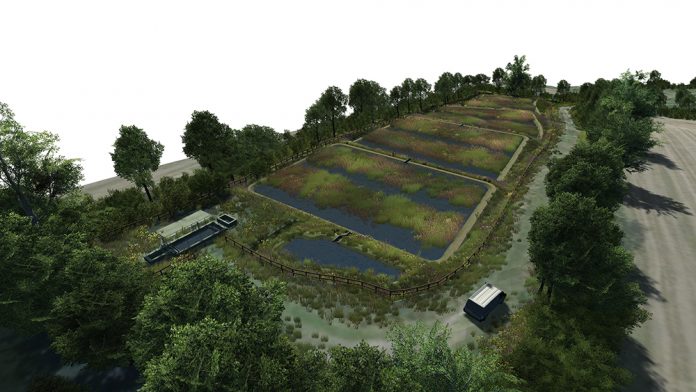Yorkshire Water and its partners Stantec and BarhaleDoosan JV are currently constructing an integrated wetland at Clifton wastewater treatment works to help reduce reliance on energy intensive treatment processes.
Here Yorkshire Water project lead Michael Housby explains the thinking behind the innovative project.
Phosphorus removal from treated wastewater is a particular focus for Yorkshire Water and all water companies alike and we have looked at a variety of innovative ways of meeting our goals in this area.
We are always looking for innovative/alternative solutions. One element of our programme identified a number of our existing sites where the creation of wetlands integrated into the treatment process could have significant benefits in terms of energy saving, carbon reduction and long-term positive impacts for the environment and local biodiversity while achieve the regulated Phosphorus performance
Integrated wetlands are considered to be low-cost, low-energy and low-maintenance in nature, compared with traditional chemical-based solutions. They are particularly well suited to rural areas, so our innovation and strategic planning teams identified our wastewater treatment works at Clifton – a small site near Doncaster – as the number one site to begin this project. As a result, we are now building a wetland which will be planted with more than 20,000 plants to naturally remove phosphorus from treated wastewater before it is returned to the environment.
The £1.2m project is the first of its kind in Yorkshire and will remove phosphorus from millions of litres of treated water in a natural, sustainable and low-carbon process, while also achieving a biodiversity net gain. The project also removed the need for carbon-intensive engineering solutions to upgrade the treatment works. The mechanically driven rotating biological contactor at Clifton required replacement and the new 4mg/l phosphorus permit would require the installation of a chemical dosing set up, new settlement tanks and regular deliveries of ferric sulphate to the small rural site.
By reducing reliance on building and grey infrastructure and removing the chemical dosing activity at Clifton, we will be enabling a 58% carbon efficiency in terms of the entirety of the scheme, with reduced operator intervention and next to no energy input, with the additional benefit of being a biodiversity net gain.
Our approach instead uses the natural slope present at the treatment works with construction of a series of shallow natural clay cells, approximately the size of three Olympic swimming pools, planted with a diverse range of native water vegetation to mimic the natural processes that occur in wetlands to remove pollutants. These cells use a combination of sedimentation filtration via the action of plants, as well as aerobic and anaerobic breakdown of pollutants by microorganisms and insects, resulting in clean water for discharge to local watercourses.
We worked hard with the Environment Agency throughout the planning stages and because of our collaboration this is one of the first projects to be delivered as part of an operating techniques agreement, which is designed to encourage innovation. The flexibility afforded by the agreement has enabled us to use natural clay in the wetland rather than an artificial pond liner, helping us to be much more integrated with nature and deliver real benefits.
To mitigate carbon and cost from significant material movements offsite, and to enhance local biodiversity, a material management plan has been approved under the CL:AIRE process to keep all excavated material on site, further reducing carbon emissions and potential disruption to local residents.
The wetland has also created opportunities for engagement with the local community. We will be engaging with local schools to get pupils involved with the planting process and asking them to build bug hotels for the new biodiversity section of the works that will be completed once the wetlands is in operation. Not only does this let the next generation play a part in establishing the new ecosystem but also gives them a first-hand opportunity to see the process and the importance of treating sewage.
To enable YW to learn from this project, we have accelerated the delivery of this project three years ahead of schedule and it really is just the start for Yorkshire Water when it comes to integrated wetlands and natural treatment solutions. Seven further sites have been identified where wetlands could be implemented and feasibility investigations are underway with our strategic planning partners Stantec. We hope to use Clifton as a potential template for future nature-based solutions to support our 2030 net zero carbon commitment and change the way in which we consider design and construction within the built environment.



